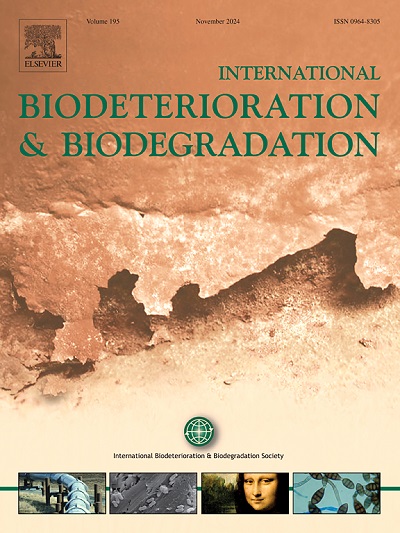原油管道残留物中不同异养兼性细菌的硫酸盐还原活性和腐蚀电位
IF 4.1
2区 环境科学与生态学
Q2 BIOTECHNOLOGY & APPLIED MICROBIOLOGY
International Biodeterioration & Biodegradation
Pub Date : 2025-06-10
DOI:10.1016/j.ibiod.2025.106138
引用次数: 0
摘要
硫酸盐还原细菌在生物地球化学循环中至关重要,可以显著影响环境和工业过程,包括生物腐蚀。本研究研究了原油管道清管作业后,从炼油厂不同地点采集的原油样品中分离出的各种异养兼性细菌的硫酸盐还原潜力。对样品进行分析,以确定微生物群落及其代谢能力。采用选择性富集的方法从原油样品中分离出阴沟肠杆菌、路德维希肠杆菌、霍氏肠杆菌、布拉氏柠檬酸杆菌、弗氏柠檬酸杆菌和赫氏Pantoea hericii。通过测定不同环境条件下硫化物的生成和生长,评价了它们的硫酸盐还原潜力。分离菌株之间硫酸盐还原活性的显著差异,其中一些表现出显着的高还原率。采用16S rRNA测序技术对菌株进行分子鉴定,并阐明其系统发育关系。此外,利用动电位极化法分析了其中最有希望的菌株E. cloacae对API 5L X65管道材料的腐蚀能力。在非生物条件下,腐蚀速率为0.09 mm /年,腐蚀电流密度为1.69 × 10−5 a cm−2。然而,当兼性阴沟杆菌存在时,腐蚀速率显著增加至0.23 mm /年,相应的Icorr值为3.29 × 10−5 A cm−2。本研究有助于更好地了解兼性硫酸盐还原菌在工业环境中的生态作用,特别是在原油加工过程中。本文章由计算机程序翻译,如有差异,请以英文原文为准。
Sulfate reducing activity and corrosion potential of diverse heterotrophic facultative bacteria isolated from crude oil pipeline residues
Sulfate-reducing bacteria are vital in biogeochemical cycles and can significantly affect both environmental and industrial processes, including biocorrosion. This study investigates the sulfate-reducing potential of various heterotrophic facultative bacteria isolated from crude oil samples collected at various points in a petroleum refinery, after a crude oil pipeline pigging operation. The samples were analysed to identify the microbial communities and their metabolic capabilities. Bacterial strains of Enterobacter cloacae, Enterobacter ludwigii, Enterobacter hormaechei, Citrobacter braakii, Citrobacter freundii and Pantoea hericii were isolated from the crude oil samples using selective enrichment. Their sulfate reducing potential was assessed by measuring sulfide production and growth under various environmental conditions. Significant variability in sulfate-reducing activity among the isolated strains, with some exhibiting notably high reduction rates. Molecular identification via 16S rRNA sequencing was employed to characterize the strains and elucidate their phylogenetic relationships. Furthermore, corrosion capacity of the most promising bacterial strain among those identified, E. cloacae on API 5L X65 pipeline material was analysed using the potentiodynamic polarization method. Under abiotic conditions, the corrosion rate was measured at 0.09 mm per year, with a corrosion current density of 1.69 × 10−5 A cm−2. However, in the presence of facultative bacterium E. cloacae, the corrosion rate increased significantly to 0.23 mm per year, accompanied by corresponding Icorr value of 3.29 × 10−5 A cm−2. This study contributes to a better understanding of the ecological roles of facultative sulfate reducing bacteria in industrial environments, especially within crude oil processing.
求助全文
通过发布文献求助,成功后即可免费获取论文全文。
去求助
来源期刊
CiteScore
9.60
自引率
10.40%
发文量
107
审稿时长
21 days
期刊介绍:
International Biodeterioration and Biodegradation publishes original research papers and reviews on the biological causes of deterioration or degradation.

 求助内容:
求助内容: 应助结果提醒方式:
应助结果提醒方式:


